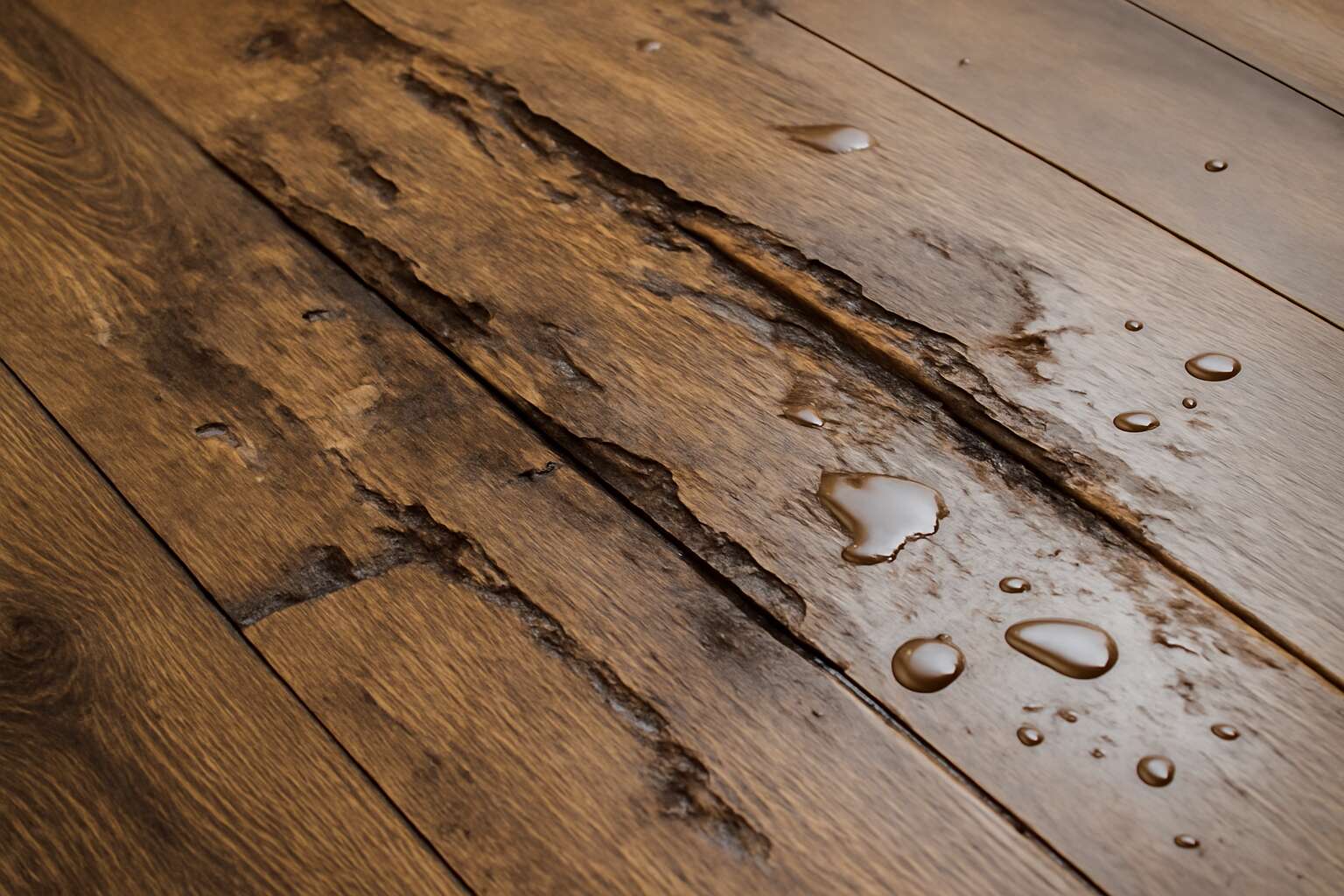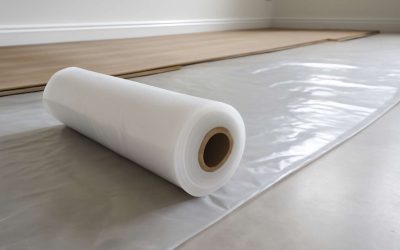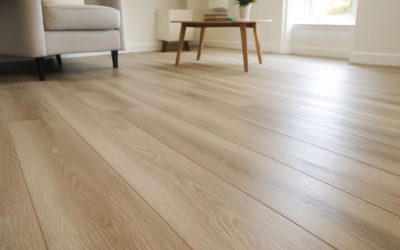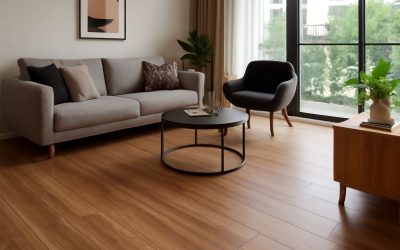Understanding Water Damage in Laminate Flooring
What Causes Water Damage in Laminate Floors – Common sources of water exposure and their impact
Water damage isn’t always as dramatic as a flooded basement; sometimes, it creeps in subtly, compromising the integrity of your laminate floor with water damage over time. Understanding the root causes is essential to prevent irreversible harm. When water seeps beneath the surface, it can cause the fibreboard core of laminate flooring to swell, warp, or delaminate—transforming a sleek surface into a distorted nightmare.
Common sources of water exposure include accidental spills, high humidity, or leaks from plumbing fixtures and appliances. These seemingly minor incidents can, if left unchecked, escalate into serious issues. The impact of water exposure varies depending on the duration and extent of exposure, but the damage to a laminate floor with water damage can be swift and severe.
- Spills from household liquids that aren’t promptly cleaned
- Persistent moisture from poor ventilation or high humidity levels
<li Leaking pipes or appliances like washing machines or dishwashers
Each source introduces a different level of threat, but the result is often the same: compromised flooring that jeopardises both aesthetics and structural stability. Recognising these triggers early can be the key to preserving your investment in laminate flooring with water damage.
Signs and Symptoms of Water-Related Damage – Visual indicators and potential hidden issues
Water damage in laminate flooring isn’t always obvious at first glance. Sometimes, it’s a sneaky culprit, hiding beneath the surface and causing chaos long before you notice. Recognising the signs early can save you a fortune and a headache—trust me, nobody wants a warped, swollen laminate floor with water damage turning their living room into a wavy nightmare.
Visual indicators are your first line of defence. Look for telltale signs like cupped or buckled planks, discolouration, or a warped appearance. These symptoms often signal water has infiltrated, compromising the integrity of your laminate floor with water damage. But beware: some issues aren’t visible to the naked eye. Hidden problems, such as mould or delamination beneath the surface, can be lurking unnoticed, silently wreaking havoc.
In some cases, a faint musty odour or an increase in humidity levels might be your only clue. It’s akin to a ghost in the machine—subtle but sinister. Regular inspections, especially in high-risk areas like kitchens or bathrooms, can help catch these signs early. After all, spotting water damage on a laminate floor before it spreads is the best way to avoid costly repairs and prolong the life of your flooring.
Differences Between Mild and Severe Damage – Assessing the extent of the problem
Understanding the severity of water damage in a laminate floor with water damage is crucial. Mild damage often presents as slight cupping or a dull appearance, with minimal impact on the surface. These issues might be reversible if caught early, allowing for thorough drying and possible repair. However, severe water damage tells a different story. When water penetrates deep into the core layers, it causes warped planks, delamination, and even mould growth beneath the surface. This level of damage compromises the structural integrity of the flooring and demands more extensive intervention—sometimes replacement.
Assessing the extent of water damage involves careful inspection. Here are some indicators to consider:
- Visual signs such as buckling, swelling, or discolouration.
- Unusual odours indicating mould or mildew beneath the surface.
- Soft or spongy flooring when pressed.
Knowing the difference between mild and severe damage can save you time and money, especially in high-risk areas like kitchens or bathrooms where water exposure is frequent. Recognising these signs early is vital to prevent further deterioration of your laminate floor with water damage, ultimately extending its lifespan and maintaining its appearance.
Assessing the Severity of Water Damage
Visual Inspection Techniques – How to examine your laminate floor thoroughly
Water’s silent infiltration can be more insidious than a sudden flood. When assessing a laminate floor with water damage, a meticulous visual inspection becomes essential—almost a form of silent interrogation. Every crack, warp, or discolouration whispers stories of moisture seeping beneath the surface, threatening the integrity of your flooring.
Begin by systematically examining the affected area. Look for uneven planks or areas where the laminate seems swell or lift—these are telltale signs of water intrusion. In some cases, damage may be concealed beneath the surface, so don’t rely solely on surface appearance. Gently press around the edges; if the floor feels soft or spongy, the damage might be more profound than it appears.
Consider employing specific visual inspection techniques, such as shining a flashlight at low angles to reveal warping or using a moisture metre to detect hidden dampness. An untrained eye might overlook subtle indicators, but a careful, layered approach can uncover the true extent of the problem. Remember, the severity of water damage in a laminate floor with water damage isn’t always immediately visible—sometimes, the most dangerous issues lie beneath the surface, waiting to manifest further down the line.
Checking for Warping, Buckling, and Discoloration – Identifying common physical damages
Water damage can transform a once pristine laminate floor with water damage into a silent testament to neglect—its scars etched in warping and discolouration. Assessing the severity of this damage requires a discerning eye that can distinguish between superficial blemishes and deeper structural issues. Warping, for instance, manifests as gentle undulations or pronounced buckling, where planks lift or ripple—visual cues that moisture has infiltrated beyond the surface. Discolouration, on the other hand, often appears as dull patches, darkened streaks, or white stains, revealing the extent of water’s silent assault.
To truly gauge the damage, you might consider examining the affected areas with a keen eye for telltale signs. An elevated level of concern arises when soft or spongy sections are felt underfoot—indicators that the core fibres have been compromised. In some cases, damage may be concealed beneath the surface, making it vital to scrutinise every detail. A simple inspection can be guided by a few steps:
- Look for uneven planks or areas where the laminate appears swollen or lifted.
- Check for discolouration patterns that diverge from the natural hue of your flooring.
- Gently press on suspect spots; softness signals potential structural failure.
Remember, water’s insidious nature means the most significant damage often lurks beneath the surface, waiting to surface later if left unchecked. Recognising these common physical damages is crucial in determining whether your laminate floor with water damage can be salvaged or if replacement becomes inevitable.
Using Moisture Meters for Accurate Assessment – Tools to determine moisture levels
Assessing the true extent of water damage in a laminate floor with water damage requires more than just a visual glance. Moisture meters have become invaluable tools for professionals and homeowners alike, offering a precise gauge of moisture levels within the flooring material. These devices penetrate beneath the surface, revealing hidden pockets of dampness that might not be immediately visible. When used correctly, a moisture meter can distinguish between minor surface moisture and serious structural infiltration, guiding decisions on repair or replacement.
For an accurate assessment, it’s recommended to check multiple points across the affected area. An elevated moisture reading—often above 12-14%—signals that water is still present deep within the laminate core. Such persistent dampness can weaken the fibres, leading to warping or buckling down the line. To streamline the process, some professionals suggest following a simple step-by-step approach:
- Calibrate the moisture meter according to the manufacturer’s instructions.
- Insert the probes into various sections of the laminate, especially areas with visible damage or swelling.
- Compare the readings to baseline levels for your specific flooring type.
Using moisture meters isn’t just about numbers; it’s about gaining a nuanced understanding of how water has affected your laminate floor with water damage. This careful evaluation helps prevent unnecessary demolition and ensures that any intervention is both timely and effective.
Immediate Steps to Take After Water Exposure
Removing Standing Water and Moisture – Best practices for drying the affected area
When water invades the sanctum of your laminate floor with water damage, swift action becomes an imperative, a race against time’s relentless march. The first step is to remove any standing water—each drop a silent harbinger of decay. Use absorbent towels or a wet-dry vacuum designed for delicate surfaces, ensuring that the water doesn’t seep further into the core of the wood-like layers.
Once the surface is cleared, the next crucial phase is drying the affected area thoroughly. Ventilate the space with fans and open windows to foster an environment unfavourable to mould’s silent invasion. For deeper moisture, employ moisture meters to gauge the extent of internal dampness—an unseen enemy lurking beneath the surface.
To expedite the drying process, consider elevating furniture and lifting loose planks if possible. Remember, in the shadows of water damage, every moment counts; neglecting prompt drying can turn minor damage into a permanent scar on your laminate floor with water damage.
Ventilating and Dehumidifying the Space – Proper airflow techniques
Once the water has been swiftly removed from your laminate floor with water damage, the battle shifts to drying and restoring the affected space. Proper ventilating and dehumidifying techniques are essential to prevent mould proliferation and further deterioration. An environment with adequate airflow acts as an invisible guardian, sweeping away the dampness that lurks beneath the surface. Open windows generously, allowing fresh air to circulate freely throughout the room. If weather permits, harness the wind’s natural energy by positioning fans strategically—pointing them outward to draw moisture away from the laminate floor with water damage.
To accelerate the drying process, consider using dehumidifiers that can extract moisture from the air, especially in spaces where humidity tends to linger. This step is crucial, as excess humidity fosters mould growth and can warp your laminate flooring. For deeper moisture trapped beneath the surface, employing moisture meters can reveal hidden dampness—those silent enemies that threaten your floor’s integrity. Remember, thorough dehumidification paired with proper ventilation is the cornerstone of effective water damage recovery, transforming a potential catastrophe into a manageable repair.
Protecting Adjacent Areas from Water Spread – Preventive measures
Once the initial floodwaters have been addressed, safeguarding surrounding areas from the insidious spread of moisture becomes paramount. Water, like an invisible predator, can seep into adjoining rooms through tiny gaps and concealed crevices, silently compounding the damage. Preventive measures are your best defence—quick, decisive action can make all the difference in preserving the integrity of your laminate floor with water damage.
Start by isolating the affected zone. Use physical barriers such as plastic sheeting or damp-proof membranes to contain the moisture and prevent its migration. Simultaneously, enhance airflow around the perimeter of the damaged area to discourage lingering dampness, which can accelerate mould growth. Remember, moisture doesn’t respect borders; it travels fast and stealthily, so vigilance is essential.
Consider employing a combination of strategic ventilation and targeted drying techniques. An ordered approach—like a carefully planned sequence—can significantly reduce the risk of secondary damage. For example, an ordered list of steps might include sealing off adjacent rooms, deploying fans to create directional airflow, and setting up dehumidifiers to extract residual moisture. Each action, layered with intent, fortifies your defence against water infiltration, ensuring your laminate floor with water damage is contained and protected from further deterioration.
Repair and Restoration Options for Water-Damaged Laminate Floors
Can Water-Damaged Laminate Be Repaired? – Factors influencing repairability
When faced with a laminate floor with water damage, the question of repairability can feel like navigating a labyrinth. The good news is that not every instance of water intrusion spells the end for your flooring. The extent of damage, the type of water exposure, and how quickly the issue is addressed all influence whether restoration is feasible. In some cases, the damage may be superficial, allowing for effective repair without complete replacement.
Factors such as the depth of water penetration and the condition of the subfloor play pivotal roles in determining if the laminate floor with water damage can be salvaged. For minor cases, targeted drying and sealing can often restore the surface. However, severe damage—like warping or delamination—may necessitate a more comprehensive approach, including removal and replacement of affected planks.
- Assessing moisture levels with precision tools to gauge the extent of damage
- Removing standing water promptly to prevent further deterioration
- Implementing advanced drying techniques to mitigate residual moisture
Ultimately, a careful inspection combined with expert evaluation will reveal if repair is possible or if complete replacement offers a more durable solution for your laminate floor with water damage.
DIY Repair Techniques – Step-by-step guides for minor damage
When water stealthily infiltrates a laminate floor with water damage, the prospect of repair can seem like a daunting quest. Yet, amidst the shadows of potential devastation, there are avenues for restoration—if approached with precision and care. For minor damage, DIY repair techniques can breathe new life into your flooring, transforming a seemingly hopeless situation into a manageable project. The key lies in understanding the extent of the damage and employing targeted methods to restore integrity.
Begin by thoroughly drying the affected area—using a combination of fans, dehumidifiers, and careful moisture removal—to halt further deterioration. Once moisture levels are stabilised, superficial scratches or discolouration may be addressed with specialised laminate floor repair kits. For surface-level issues, a gentle sanding followed by sealing can often suffice, preventing water from seeping deeper into the structure. Remember, patience and attention to detail are your allies in this restorative journey.
In cases of minor damage, you can follow a simple step-by-step process:
- Clear the area of loose debris and standing water.
- Use a moisture metre to assess residual dampness.
- Apply a suitable drying technique to eliminate hidden moisture.
- Perform surface repairs with laminate-specific fillers or sealants, if necessary.
- Finish with a protective coating to safeguard against future water intrusion.
While DIY methods offer a lifeline for small-scale issues, remember that persistent or severe damage—like warping or delamination—may require professional intervention. Nonetheless, understanding these repair techniques can empower homeowners to tackle minor water-related woes and preserve the splendour of their laminate floor with water damage.
Professional Repair and Replacement – When to call in experts and what to expect
When water seeps into a laminate floor with water damage, the temptation to rip everything out can be overwhelming. However, a professional repair or replacement isn’t always necessary—sometimes, expert intervention can restore the floor’s former glory with finesse. Skilled technicians assess the extent of the damage, employing advanced tools such as moisture meters and specialised drying techniques to evaluate and address the problem comprehensively.
In cases where the damage is confined to surface layers or minor warping, professionals may opt for targeted repairs—replacing damaged planks, re-sealing seams, or applying specialised laminate repair kits. For more severe cases involving delamination or significant warping, a full replacement of affected sections might be the best course of action.
- Precise assessment of moisture levels
- Careful removal of compromised planks
- Application of high-quality sealants and underlays
Ultimately, understanding when to call in the experts can save both time and money, ensuring your laminate floor with water damage is restored to its original splendour—whether through delicate repairs or complete renewal. The decision hinges on the severity of the damage and the intricate dance between moisture and material, a dance best performed by those with seasoned expertise in floor restoration.
Preventative Measures for Water Damage
Sealing and Protecting Laminate Floors – Use of sealants and protective coatings
Water damage on a laminate floor can escalate from a minor inconvenience to a full-blown disaster in a matter of hours. The key to minimising damage lies in proactive sealing and protective measures. Applying high-quality sealants creates a formidable barrier against water infiltration, effectively preventing moisture from seeping into the core of your laminate flooring. Protective coatings, such as water-resistant sealants, can also serve as an extra line of defence—especially in high-risk areas like kitchens and bathrooms.
To enhance your efforts, consider the strategic use of sealants designed specifically for laminate flooring. These products fill in microscopic pores and cracks, making it difficult for water to penetrate. Additionally, proper sealing isn’t a one-time task; it requires regular inspection and reapplication to maintain its efficacy. An ounce of prevention can save you from costly repairs and the heartbreak of a laminate floor with water damage.
Furthermore, safeguarding adjacent areas from water spread is crucial. Using barrier mats or sealing thresholds can stop water from migrating across rooms, reducing the risk of widespread damage. Remember, the goal is to create an environment where even accidental spills or leaks won’t turn your beautiful laminate floor into a war zone. Prevention isn’t just about damage control—it’s about preserving the integrity and longevity of your flooring investment.
Flooring Choices and Alternatives – Water-resistant flooring options
Choosing the right flooring solution can make all the difference when it comes to water-related mishaps. Water-resistant flooring options are increasingly popular for areas prone to spills or leaks. Materials like luxury vinyl planks, ceramic tiles, or epoxy coatings provide a sturdy alternative to laminate flooring with water damage vulnerabilities.
For homeowners seeking peace of mind, considering these alternatives offers a proactive approach. Waterproof vinyl flooring, for example, resists moisture and is easy to maintain. Meanwhile, engineered hardwood with a sealed surface can mimic natural wood without the susceptibility to water damage.
- Vinyl composite tiles
- Waterproof laminate alternatives
- Polymer-based resilient flooring
Implementing preventative measures such as installing moisture barriers or using water-resistant underlayments can further shield your floors from water incursion. If water exposure is a recurring hazard, investing in flooring designed specifically to withstand moisture not only preserves aesthetic appeal but also extends the lifespan of your investment. When it comes to laminate floors, opting for water-resistant options can save significant repair costs and stress in the long run.
Maintenance Tips to Prevent Future Damage – Routine care practices
Water damage to a laminate floor can feel like an invasion — sudden, unwelcome, and disruptive to the fabric of your home. Yet, the most effective defence often begins long before water ever appears. Preventative measures serve as the silent guardians of your flooring investment, reducing the risk of costly repairs and emotional distress. Regular inspection is key; a vigilant eye can catch early signs of moisture intrusion before it morphs into visible damage. Using moisture meters to assess the subtle, hidden levels of dampness provides a scientific edge, revealing vulnerabilities that naked eyes might overlook.
In addition, implementing protective strategies such as installing water-resistant underlayments or applying sealants creates an impermeable barrier against water infiltration. For areas prone to spills or leaks, consider a layered approach: a combination of physical barriers and proactive maintenance. An ordered series of steps can be especially effective:
- Check for signs of warping, buckling, or discolouration regularly.
- Remove standing water promptly, ensuring thorough drying of the affected zone.
- Increase ventilation and use dehumidifiers to foster a dry environment, discouraging mould and further damage.
By embedding these practices into your routine, you transform your home from a passive space into a resilient sanctuary. The pursuit of preventative care is not merely about safeguarding a laminate floor with water damage — it’s about honouring the integrity of your living space and the peace of mind that comes with it. Each small act of vigilance becomes a powerful statement against the chaos water can unleash.
Selecting the Right Water-Resistant Laminate Flooring
Features of Water-Resistant and Waterproof Laminate – Key specifications to look for
Choosing the right water-resistant laminate flooring can feel like navigating a maze, but it’s worth the effort. Not all laminate floors are created equal—some boast features designed to withstand moisture, while others fold under pressure. When selecting a laminate floor with water damage in mind, look for key specifications that promise durability and resilience.
Water-resistant and waterproof laminate options often feature advanced core materials that prevent moisture from seeping in. For example, high-density fibreboard (HDF) cores with water-resistant coatings create a formidable barrier against spills and humidity. Additionally, click-lock systems with tight seals help keep water out of the seams, reducing the risk of swelling and warping. Keep an eye out for flooring with these attributes to ensure longevity and peace of mind.
- Waterproof core layers
- Enhanced edge sealing
- UV-resistant surface finish
Ultimately, choosing a laminate floor with water damage resistance isn’t just about immediate protection—it’s an investment in long-term flooring integrity. With the right specifications, your floor can handle the unexpected splash or leak with a bit more grace, saving you from costly repairs and replacements down the line.
Top Brands and Products – Recommended options in the market
When selecting a laminate floor with water damage in mind, it’s essential to turn towards trusted brands renowned for their durability and advanced water-resistant features. Top-tier manufacturers like Pergo, Quick-Step, and Krono Original have carved a niche by integrating innovative water-resistant core layers and sealed edges into their products. These brands offer a diverse range of options designed to withstand moisture, making them ideal for households prone to spills or humidity fluctuations.
For those seeking the best in water-resistant laminate flooring, it’s wise to focus on products that feature waterproof core layers, enhanced edge sealing, and UV-resistant surface finishes. Such specifications significantly reduce the risk of water ingress and minimise long-term damage. Many of these brands also provide detailed product guarantees, underscoring their commitment to quality and resilience.
While choosing the right product is vital, understanding which options suit your specific needs can be a nuanced process. Here are some recommended options that consistently receive positive reviews:
- Pergo Max waterproof laminate – Known for its superior water resistance and easy installation system.
- Quick-Step Livyn waterproof collection – Offers excellent moisture protection with stylish finishes.
- Krono Original Aqua+ – Features a durable, water-resistant core with enhanced edge sealing for added peace of mind.
Selecting from these reputable brands ensures that your investment in a laminate floor with water damage resistance will stand the test of time, offering both protection and aesthetic appeal.
Installation Tips for Durability – Best practices for longevity and protection
Choosing the right water-resistant laminate flooring installation is an investment in longevity and peace of mind. When it comes to a laminate floor with water damage, proper installation practices can significantly mitigate risks and extend its lifespan. One essential aspect is ensuring the subfloor is perfectly level and dry before laying the planks—any unevenness can trap moisture and hasten deterioration.
Incorporating moisture barriers and sealing edges during installation offers an extra layer of protection. For added resilience, consider using products with waterproof core layers—these are designed to repel water rather than absorb it. Additionally, paying attention to the installation environment—such as maintaining optimal humidity levels—can prevent future water ingress issues.
- Ensure thorough sealing of all seams and joints.
- Use high-quality underlayments that wick away moisture.
- Avoid excessive water exposure during and after installation.
By adhering to these best practices, you help guarantee that your laminate floor with water damage remains durable and visually appealing, even in moisture-prone areas. It’s a delicate balance—one that demands both meticulous attention to detail and a proactive approach to safeguarding your flooring investment.




0 Comments